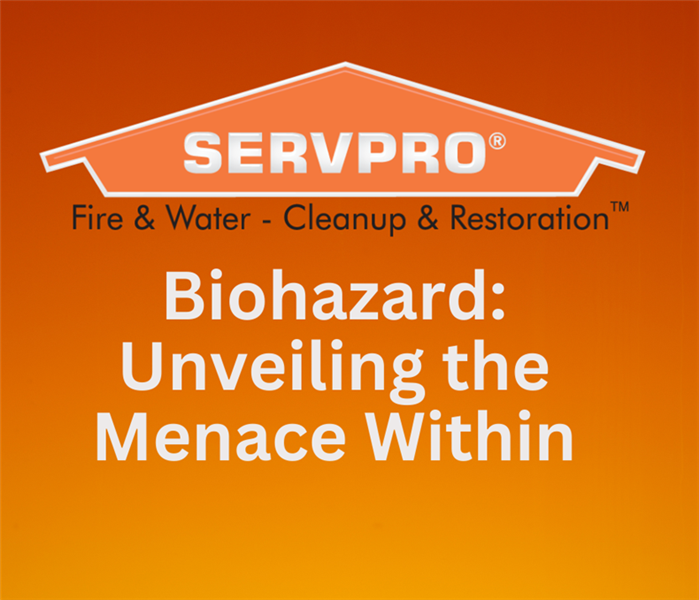Biohazard: Unveiling the Menace Within
7/7/2023 (Permalink)
 It is essential to shed light on biohazards, their diverse forms, and the importance of effective management to ensure our well-being.
It is essential to shed light on biohazards, their diverse forms, and the importance of effective management to ensure our well-being.
In our modern world, we are constantly exposed to potential threats, some of which remain unseen, yet capable of causing harm. Among these hidden perils, biohazards stand as a significant risk to both human health and the environment. Defined as biological agents or substances that pose a threat to living organisms, biohazards have garnered increasing concern in recent times. It is essential to shed light on biohazards, their diverse forms, and the importance of effective management to ensure our well-being remains safeguarded.
Understanding Biohazards: Biohazards encompass a wide array of hazardous agents, including bacteria, viruses, toxins, fungi, and other biological substances. These potential threats can be found in various environments such as laboratories, hospitals, industrial settings, and even natural ecosystems. What makes biohazards particularly dangerous is their capacity to cause infections, diseases, and severe health complications in both humans and animals.
Types of Biohazards: Biohazards manifest in several forms, each presenting unique challenges and risks. Here are some common types of biohazards:
Biological Agents: This category includes pathogenic microorganisms such as bacteria, viruses, fungi, and parasites. Well-known examples of biohazards include Salmonella, E. coli, HIV, influenza, and anthrax. These agents can spread through direct contact, droplets, contaminated food or water, or via vectors like mosquitoes.
Biomedical Waste: Medical facilities generate significant amounts of hazardous waste, including used needles, blood-soaked materials, contaminated sharps, and pharmaceutical waste. Improper handling or disposal of these materials can lead to the spread of infections and endanger public health.
Genetically Modified Organisms (GMOs): While GMOs have their benefits in agriculture and medical research, their uncontrolled release or mishandling can have unintended consequences. These genetically altered organisms may disrupt ecosystems and pose risks to native species if not properly managed.
Chemical Agents: Biohazards can also take the form of toxic chemicals or toxins produced by organisms. Pesticides, heavy metals, and industrial pollutants, when released into the environment, can contaminate air, water, and soil, endangering human and animal life.
Managing Biohazards: Effectively managing biohazards is crucial for protecting public health, preserving the environment, and preventing the spread of diseases. Here are some key aspects of biohazard management:
Risk Assessment and Prevention: Identifying potential biohazards, evaluating their risks, and implementing preventive measures are vital. This includes providing proper training and education for individuals working with biohazardous materials, implementing safety protocols, and enforcing regulations to minimize exposure and transmission.
Proper Handling and Disposal: Safe handling, storage, and disposal of biohazardous materials are of utmost importance. Strict adherence to guidelines, such as using personal protective equipment (PPE), following decontamination procedures, and employing specialized waste disposal methods, helps minimize the risks associated with biohazards.
Research and Development: Ongoing scientific research plays a crucial role in understanding biohazards, their behavior, and developing effective countermeasures. Investing in research and development of vaccines, antiviral drugs, and diagnostic tools aids in the prevention and management of biohazard outbreaks.
Public Awareness and Education: Educating the general public about biohazards, their potential risks, and proper precautions fosters a culture of safety and responsibility. Awareness campaigns, public health initiatives, and educational programs can empower individuals to protect themselves and their communities.
Biohazards pose a significant threat to human health, the environment, and overall well-being. Understanding the various types of biohazards, implementing effective management strategies, and promoting awareness are crucial steps toward mitigating these risks.
If you require cleanup and restoration services for residential or commercial buildings affected by fire, mold, water, or storm damage, SERVPRO Of Foxborough is the #1 Choice. They serve Bellingham, Foxborough, Franklin, Millis, Norfolk, Wethersfield, and Wrentham, MA.




 24/7 Emergency Service
24/7 Emergency Service